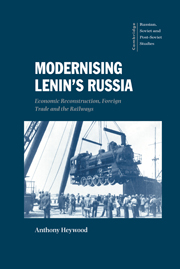Book contents
- Frontmatter
- Contents
- List of illustrations
- List of tables
- Acknowledgements
- Technical note
- List of abbreviations and acronyms
- Introduction
- PART I Towards economic reconstruction, 1917–1920 the birth of the railway imports policy
- PART II Trade and isolation, 1920–1921 implementing the railway imports policy
- 3 Krasin's first results
- 4 Approaches to Britain and Germany
- 5 Second thoughts
- PART III Retreat, 1921–1924
- Conclusion
- Notes
- Bibliography
- Index
- Cambridge Russian, Soviet and Post-Soviet Studies
- Plate Section
3 - Krasin's first results
Published online by Cambridge University Press: 14 August 2009
- Frontmatter
- Contents
- List of illustrations
- List of tables
- Acknowledgements
- Technical note
- List of abbreviations and acronyms
- Introduction
- PART I Towards economic reconstruction, 1917–1920 the birth of the railway imports policy
- PART II Trade and isolation, 1920–1921 implementing the railway imports policy
- 3 Krasin's first results
- 4 Approaches to Britain and Germany
- 5 Second thoughts
- PART III Retreat, 1921–1924
- Conclusion
- Notes
- Bibliography
- Index
- Cambridge Russian, Soviet and Post-Soviet Studies
- Plate Section
Summary
The departure of Krasin from Moscow in March 1920 at the head of the Tsentrosoiuz delegation marked the beginning of a year which one might call the heroic period in interwar Soviet–Western trade relations. Krasin, who based himself in Scandinavia for several months and then in London from late May 1920, aimed to implement an imports plan of epic proportions with its unprecedented goal of 5,000 locomotives and 100,000 wagons, not to mention the other railway supplies and requests from other commissariats. Trotskii meanwhile took control of the NKPS with his own distinctive agenda for reconstruction. Trotskii's achievements and problems at the commissariat have been discussed elsewhere and need be examined only briefly in chapter 5; the success of Krasin and his colleagues in agreeing a series of remarkable contracts for the NKPS by March 1921, notably three firm agreements for 1,700 new Class E freight locomotives, forms the main subject of this and the following two chapters.
The American dream
Although Chicherin, Litvinov, Krasin and others had been calling for trade with any and every capitalist country, they evidently preferred the United States. One reason for this was the substantial amount of equipment ordered by previous Russian governments – including 200 decapod locomotives – which remained there. Furthermore, it was widely felt that only the USA had sufficient spare capacity to massproduce quickly enough the desired vast quantities of equipment.
- Type
- Chapter
- Information
- Modernising Lenin's RussiaEconomic Reconstruction, Foreign Trade and the Railways, pp. 85 - 109Publisher: Cambridge University PressPrint publication year: 1999
- 1
- Cited by

